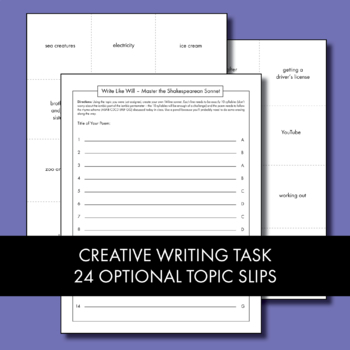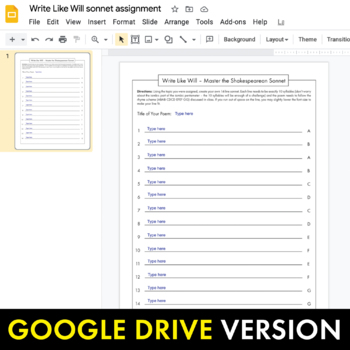Shakespearean Sonnet, Iambic Pentameter + Creative Writing, PDF & Google Drive
- Zip
- Google Apps™

What educators are saying
Description
Get your students excited about Shakespeare with this introduction to the Bard’s sonnet structure and iambic pentameter. Every eye in the room will be glued to the vibrant, information-packed slides in this poetry presentation.
This 28-slide deck (downloads in both Prezi and Google Slides format) includes detailed descriptions of iambic pentameter, iams, rhyme scheme, and Shakespeare's sonnet structure. Skills are put into practice with a close look at Sonnet 18 and Sonnet 130. You can use the slides as a stand-alone lecture (about 25 minutes) or pair it with the bonus poetry writing activity where students create their own sonnet on a variety of modern topics. The creative writing activity will take students another 20-to-25 minutes to complete, though some students will likely need to finish it as homework.
Package includes:
28 slides (both Prezi and Google Slides format)
1-page handout of sonnet assignment (printable PDF and Google Drive version), to be completed either in class or as homework
2 pages of 24 sonnet topic suggestions to use as a topic selection grab bag
Looking for more fresh ideas to use with your study of Shakespeare?
Click HERE for a full-class period Globe Theatre lecture and fun, hands-on activity
Click HERE for fun Shakespearean Insult/Flattery Contest Materials
Click HERE for scene-by-scene worksheets for Romeo & Juliet
How about an entire FIVE WEEK UNIT of Romeo & Juliet lessons (including this one) at a budget price? Click HERE for the Entire Romeo and Juliet Unit Plan This bundle features HUGE savings and features MANY items not sold separately. Check it out!
Please note that this item is also included in my A Midsummer Night's Dream unit and my four-week poetry unit. Click HERE to check out my money-saving poetry lesson bundle. If you purchase the AMSN'sD, poetry unit, or Romeo & Juliet bundles, there's no need to buy this item separately.
Finally, this item is also included in my English 9-10 full-year curriculum. If you already own the full-year download, please do not purchase this item here individually. If you’d like to receive this item plus everything else needed to teach 180 days of English 9 or English 10 at a deeply discounted price, click here to learn more about the full-year curriculum download.
Thanks for stopping by!
Image credit: John Taylor, National Portrait Gallery, WikiMedia Commons, PD-ART, Public domain





